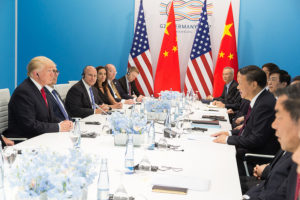
President Donald J. Trump and President Xi Jinping | July 8, 2017 (Official White House Photo by Shealah Craighead)
The Trump administration has decided not to impose $150 billion in tariffs on China. According to the FT, the Trump administration caved on its demands for China to stop subsidizing favored industries and engaging in other troublesome behavior so long as China buys more American goods. This is a rather disappointing end to the tough-on-China trade policy. The U.S. says it will consider putting tariffs back on the table if China doesn’t live up to its commitments. But who is kidding who here?
It would seem China has outmaneuvered Trump. Trump’s presidency ends in two years, or six years if he’s lucky. What is to stop China from doing as little as possible and running out the clock on the Trump administration? Chances are the next president won’t be bold enough to threaten unilateral tariffs on China.
What is most disturbing about this deal is that the U.S. apparently has industry by industry targets in mind for China’s purchases. Is the U.S. now playing China’s game by favoring certain industries over others?
Critics in the US are also concerned that its main emphasis appears to be on meeting Mr Trump’s goal of reducing the US’s annual $337bn trade deficit with China rather than tackling more difficult structural issues in the Chinese economy, such as Beijing’s subsidisation of key industries and systemic theft of US intellectual property.
Mr Mnuchin insisted on Sunday that Chinese commitments to addressing such issues were part of the broader deal and warned that Mr Trump would be free to impose tariffs if Beijing did not live up to its commitments.
He said the two sides had made “meaningful progress”, adding: “We have agreed to put the tariffs on hold while we try to execute the framework.”
But he and other advocates within the administration of reaching a quick deal with Beijing face scepticism from a US business community that sees those structural issues as a more important endeavour than reducing the trade deficit.
Read more here.
